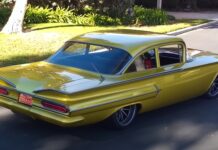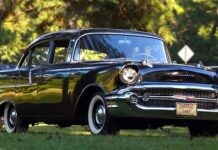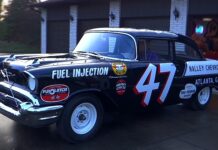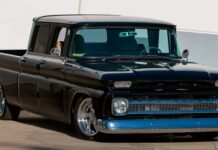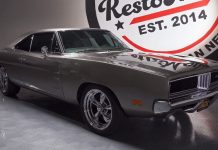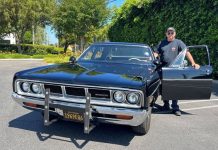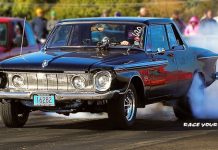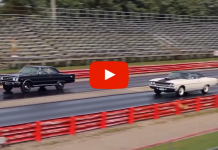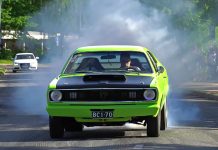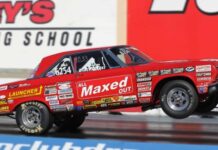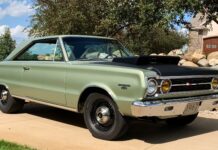Are you ready to dive into the world of classic car repair and maintenance? You've come to the right place! In this blog, we'll dish out the 3 most important tips for making sure your beloved classic gets the TLC it deserves.
You see, owning a classic car isn't just about turning heads as you cruise down the street; it's also about the satisfaction of preserving a piece of automotive history. And, let's be real, that can be a bit of a challenge.
But no worries, amigos! With the right know-how, you'll be able to tackle classic car repair like a pro and keep your beauty running for years to come. We'll show you how to find the best mechanic, keep up with preventive maintenance, and select the right parts and tools. Buckle up and let's ride!
Defining what exactly makes a car "classic" can be confusing, especially as the term is often used interchangeably with "vintage" and "antique". In fact, many people use "classic" to describe any old car that seems out of place among modern vehicles on the road.
While there are some generally accepted guidelines for what constitutes a classic car, there is no one-size-fits-all definition. For example, a classic car is typically at least 20 years old, while antique cars must be at least 45 years old, and vintage cars were built between 1919 and 1930.
However, different organizations, like state DMVs, insurance companies, and classic car clubs, may use different criteria for classification, resulting in overlap between categories.
In California, the definition of a "classic" car is particularly broad, with no distinction made between classic, vintage, and antique cars. According to the California DMV, a vehicle is considered a "Historical Vehicle" if it was manufactured after 1922 and is at least 25 years old.
However, if it has a 16-cylinder or larger engine and was made between 1922 and 1965, it is classified as a "Horseless Carriage". Modified cars and replicas are not included in either category.
Insurance companies also have their own guidelines for what constitutes a classic car. For instance, Hagerty considers cars made between 1900 and 1979 to be either antique or classic. If a car was manufactured in 1980 or later, it is considered a collector car.
Some classic car organizations, like the Classic Car Club of America (CCCA), have even more stringent criteria. The CCCA considers only cars produced between 1915 and 1948 to be classic, and only if they are distinguished by superior design, engineering, and workmanship.
Classic Car Repair and Maintenance Tips
1. Ensure Proper Maintenance of Your Car's Braking System
Instead of waiting for unsettling noises to arise, take a proactive approach to classic car care. Regularly check your brakes to prevent excessive wear on the brake pads and ensure an adequate level of brake fluid.
If you notice any signs of leaking brake fluid, immediate repairs by trusted classic car mechanics are necessary. Refer to your car's owner manual for detailed instructions.
2. Pay Attention to Your Tires and Give Them the Care They Deserve
According to the National Highway Traffic Safety Administration (NHTSA), vehicles with tires that are underinflated by over 25 per cent have a threefold increase in collision risks. Shockingly, underinflated tires contribute to approximately 660 highway fatalities and 33,000 injuries each year.
Make it a priority to periodically rotate your tires and keep a reliable tire gauge in your car at all times. Regularly check the air pressure to ensure it aligns with the recommended range provided by your vehicle manufacturer, usually between 30 and 35 PSI. Consult your owner's manual for precise details.
Taking care of your tires, just like following other essential old car maintenance tips, not only benefits your vehicle but also helps you save money by improving fuel efficiency and reducing your expenditure on gasoline.
3. Safeguard Your Steering System's Well-Being
Steering and suspension issues not only impact your ability to steer smoothly but also accelerate tire wear.
Avoid these problems by scheduling regular classic car repairs and maintenance tasks, such as changing the steering fluid and having your shocks inspected by a professional mechanic specializing in classic car repair.
By addressing these concerns promptly, you can ensure a safer and smoother driving experience.
4. Take Care of Your Windshield Wipers.
Clear visibility is crucial for safe driving, and surprisingly, replacing your windshield wiper blades can cost as little as $15.
Though seemingly minor, this classic car maintenance task holds great significance. Mastering the art of preserving a restored old car involves paying attention to even the smallest details.
5. Pay Attention to Your Radiator Hoses.
As part of maintaining a restored old car, it's important to periodically replace all the hoses. With the passage of time, classic cars often require the replacement of every single hose.
In fact, it's highly likely that your heater hose, responsible for transferring coolant to the radiator, has never been changed. Make sure to consult experienced classic car mechanics to ensure proper replacement and restoration for classic cars.
6. Don't Neglect Your Fuel Line.
Over time, fuel lines in ageing cars tend to develop cracks, leading to fuel leakage. Ignoring the need for a fuel line replacement can potentially result in a hazardous fire.
Fixing a leaking fuel line is a routine procedure for most auto repair shops. Additionally, it's recommended to have your fuel filter replaced every 10,000 miles.
7. Keep an Eye on Your CV Joints.
If you own a front-wheel-drive vehicle that's starting to show its age, you might notice a clicking sound when making sharp turns. This could be an indication that your constant velocity (CV) joints need replacement. Upon inspection, you may discover torn or missing boots surrounding the CV joints.
8. Timing Belt for Engine
Consult your vehicle's manual to determine if your car has an interference engine. If it does, and your car's mileage reaches 60,000 to 100,000 miles, it's essential to replace the timing belt to avoid potential breakdowns and more severe issues.
Even if your car doesn't have an interference engine, it's still wise to have the timing belt inspected at this mileage milestone.
Caring for an old car is akin to taking care of our own well-being as we age. While we may delay it, there comes a point when seeking professional care becomes necessary. The longer we postpone it, the higher the risks involved.
9. Replacement of All Belts and Hoses
Belts and hoses naturally degrade over time, and their condition may not always be evident through visual inspection. Typically, when a mechanic services a car and replaces the timing belt, they remove all the belts.
It's a smart move to have all the belts and hoses replaced together as part of comprehensive maintenance for an older vehicle. This approach ensures crucial components are taken care of simultaneously without breaking the bank.
10. Maintaining the Cooling System
Keeping the coolant levels properly maintained is crucial. During summer, coolant (also known as antifreeze) helps regulate the engine temperature, while in winter, it prevents freezing. Additionally, it plays a role in preventing corrosion, foam formation, and deposits that can impede your car's performance.
11. Replacement of the Water Pump
The water pump is a vital component of your engine as it ensures the continuous circulation of coolant to prevent overheating. Similar to the timing belt, it is recommended to replace the water pump, along with the timing belt, before it fails, typically around 60,000 to 90,000 miles.
12. Battery Maintenance
Ensure that your battery cables and their connections are thoroughly inspected, and remember to remove any rust or corrosion from the battery terminals. An effective solution can be made by combining baking soda with water, along with the addition of an anti-corrosion chemical. You'll be amazed at the results!
13. Oil and Filter Change
The engine's lubrication is dependent on clean oil, and neglecting its maintenance by driving with low oil levels, no oil at all, or dirty oil can lead to severe engine damage.
To avoid this risk, it is crucial to have your oil and filter changed every 3,000 miles. If you use synthetic oil, you can extend this interval to 5,000 miles. We cannot emphasize enough the significance of this classic car maintenance tip!
14. Transmission Fluid and Filter Replacement
Likewise, if your car has an automatic transmission, it is essential to have the transmission fluid flushed and the filter replaced. This proactive measure ensures smooth operation and prolongs the life of your transmission.
15. Evaluate Your Driving Habits
Taking care of an old car also involves adopting a suitable driving style. Consistently subjecting your vehicle to abrupt acceleration, sudden braking, or unnecessarily sharp turns over time can cause excessive strain on your suspension and drivetrain components.
To extend the lifespan of your car and minimize the risk of accidents, it's crucial to drive gently and safely.
A Little History of Classic Cars
Classic cars have transcended their role as mere modes of transportation, becoming symbols of a bygone era that encapsulates the brilliance of design, engineering, and cultural significance of the past. Delving into the origins of these timeless vehicles can be an exhilarating and gratifying journey for automotive enthusiasts.
The allure of classic cars lies not only in their functionality but also in their unparalleled aesthetics, which pay homage to the ingenuity and artistry of a bygone era.
Take, for example, the sleek contours and chrome embellishments of 1950s models or the bold lines and aerodynamic profiles of 70s muscle cars. These remarkable elements are a testament to the craftsmanship and beauty that characterized classic automobiles.
Beyond their visual appeal, classic cars hold profound societal relevance, reflecting the economic shifts and technological advancements of their time. They embody the inception of the modern automobile industry and the development of contemporary car culture, particularly within the United States throughout the previous century.
Classic cars serve as a source of inspiration, infusing a touch of nostalgia into present-day vehicles.
Moreover, a comprehensive understanding of the history of vintage automobiles is invaluable for collectors, as it enables them to assess the true value, variety, and exclusivity of their prized possessions.
By delving into the precise origins and evolutionary aspects of classic cars, both buyers and sellers can make informed decisions and ensure meticulous maintenance, ensuring a hassle-free experience when acquiring or selling these cherished vehicles.
Common Classic Car Problems and Solutions
As a classic car owner, it's not enjoyable to have a vintage beauty that you can't take for a spin. However, it's crucial to acknowledge that not all classic cars are designed to thrive in modern driving conditions.
With evolving road regulations, technologies, lifestyles, and driving requirements, it's essential to prioritize regular maintenance for your cherished vehicle.
In this part of the article, we'll delve into seven straightforward maintenance tips specifically tailored for classic cars, ensuring your wheels are always ready to hit the road.
Overheating
Classic cars frequently experience overheating issues due to their lack of advanced cooling systems. Fortunately, there are various solutions available to tackle this problem. In fact, in certain cases, you can even resolve the issue through do-it-yourself methods. Some potential causes of overheating include:
- Inadequate coolant level
- Malfunctioning cooling fan
- Damaged fan belt
- Faulty thermostat
- Clogged radiator pipes
To ensure your vintage car stays road-ready, it's important to regularly check and maintain the coolant at the appropriate level. Periodic inspections by a reliable mechanic are also recommended to identify any faulty components. When replacing parts, always opt for genuine spare parts.
Brake Malfunctions
Brake maintenance plays a critical role in ensuring your safety while driving. Whether your classic car has drum brakes or disc brakes, every braking system has a lifespan and requires periodic inspections.
Unlike modern cars, vintage cars often lack brake warning lights, making it challenging to assess the current condition of the brake system. Brake pads wear out over time and with usage, so it's important to monitor the brake fluid level and ensure it remains at the recommended level to prevent premature replacement.
Pest Infestation
Despite sounding unusual, pest infestation is a common issue in vintage cars, particularly if they have been left unused for extended periods. Factors such as food crumbs, worn-out door seals, missing car accessories, and climatic conditions contribute to pest problems.
If you notice any signs of infestation, there are numerous pest control products specifically designed for automobiles. Additionally, it's essential to have your car thoroughly inspected for any openings in its body that could provide easy access to pests.
Electrical Malfunctions
Each classic car is equipped with various electrical components responsible for routing power to different parts of the vehicle and its controls. The electrical system typically consists of a battery, starter, and alternator.
The lifespan of batteries usually ranges from 3 to 7 years, depending on usage. When purchasing a used vintage car, especially from classic car auctions, it is advisable to have the electrical system inspected and consider replacing the battery if necessary.
An experienced mechanic can perform a thorough electrical system check to ensure all components are functioning properly.
Engine Breakdown
Older engines are often susceptible to damage if they have been running with burnt engine oil for an extended period. Engine oil plays a crucial role in lubricating the internal moving parts of the engine, minimizing wear and tear. It is essential to regularly check the engine oil level of your classic car after approximately 2000 miles of driving.
To check the oil level, simply pull out the dipstick from the engine and wipe off any oil residue from its surface. Then, reinsert the dipstick back into the designated slot and pull it out once again. This time, examine the texture of the oil coating at the end of the dipstick.
Each dipstick is marked with a standard level indicator, such as the letters "L" and "H," or the words "MIN" and "MAX," or even two pinholes. If the oil quantity falls below the adequate level, you know it's time to add more.
Paint Chipping or Fading
Whether you have restored your classic car to its former glory or prefer to maintain its original appearance, it is important to avoid using harsh cleaning agents that claim to make it "as good as new." Such cleaning agents often strip away the natural lustre of the paint and can also leave chrome parts looking dull.
In fact, even using a dry cloth to remove dust can have a negative impact on your car's overall appeal. Dust particles can diminish the beauty of your vehicle. Whenever your car is not looking its best, consider parking it in a shaded area and simply rinsing off the dirt with a hose or taking it to a car wash.
Use a pH-balanced car wash soap (preferably with a pH level of 7) along with a car wash mitt or sponge.
Wheel Bubbling and Vibrations
Proper wheel alignment and balancing are crucial for older cars, especially those that have undergone significant repairs, modifications, or restorations. Maintaining proper wheel alignment and balance is not only essential for a smooth drive but also ensures optimal tire lifespan.
Correct wheel alignment and balance also contribute to better handling while driving, preventing the car from pulling in one direction or experiencing unusual vibrations on the road.
If you notice bubbling on the wheels or your car tends to drift to one side without your input, it is recommended to have the alignment checked by a wheel specialist. Based on the specific issue, the expert may recommend alignment, balancing, or both as necessary.
Classic Car Repair & Maintenance: Mastering the Essentials
As we cruise down this classic car repair journey, it's time to wrap things up and give you folks one last push in the right direction. Keeping your timeless beauties in tip-top shape is an art, and with these 15 most important tips, you'll have the expertise to ensure your ride gets the care it deserves.
If you follow these tips, not only will you save yourself some headaches, but you'll also be able to enjoy your classic car for years to come.
Lastly, don't forget that the classic car community is an incredible resource. Whether you're swapping stories, seeking advice, or just admiring each other's rides, connecting with fellow enthusiasts will enrich your classic car ownership experience. So, gear up and hit the road with confidence, knowing you're well-prepared to tackle any classic car repair challenges that come your way.

